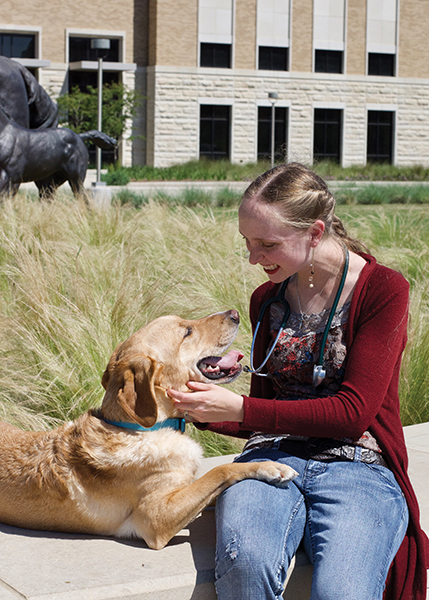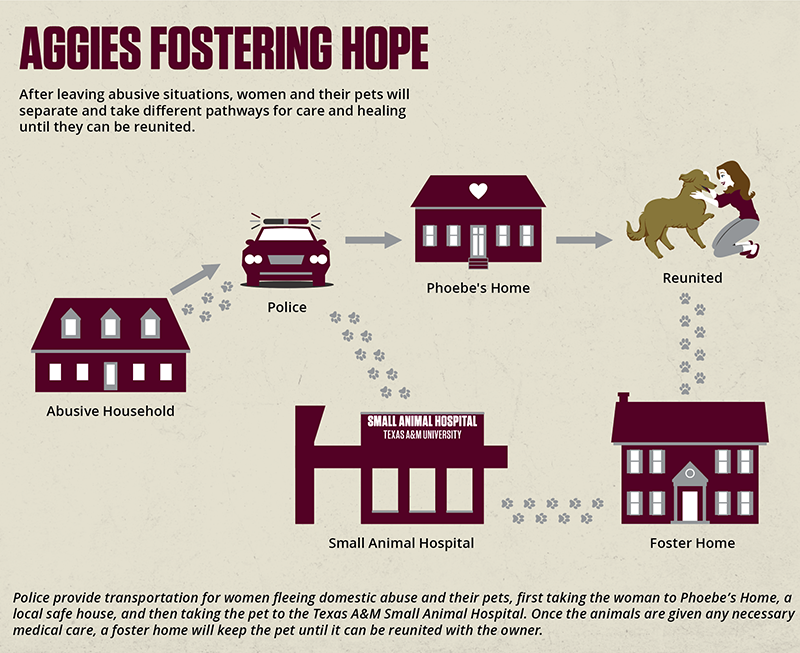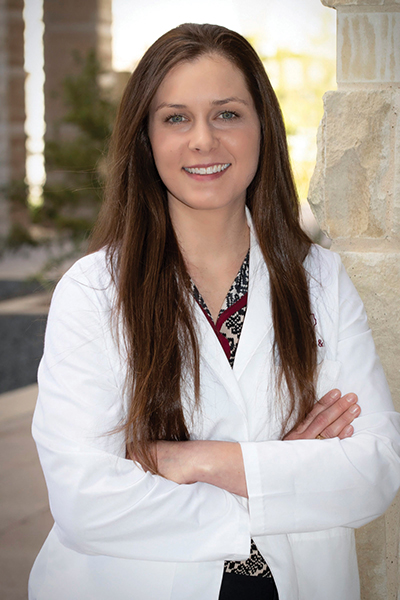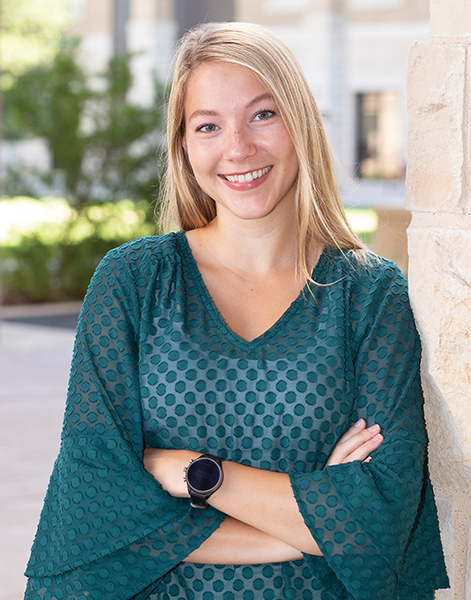Fostering a Community of Hope
Story by Megan Myers, CVMBS Communications
CVM veterinary students give back to the Bryan/College Station community by creating a program
to help local domestic abuse victims—and their pets.

Years of research has made it clear that there is a strong link between animal abuse and domestic violence.
According to past research by faculty members of the Texas A&M College of Veterinary Medicine & Biomedical Sciences (CVM), 71 percent of battered women reported that their abusers threatened or harmed their pets, as well, usually in an effort to gain control over the victim. In addition, 40 percent of those women delayed escaping an abusive situation if it meant leaving a pet behind.
To help both these women and their pets, a group of CVM students have created Aggies Fostering Hope, a program that has the potential to improve, and possibly even save, the lives of local women suffering from domestic abuse by providing them with a safe, temporary home for their pets.
The program was created by fourth-year veterinary student Hunter Greer and was further developed by a group of third-year students led by Melodie Raese and Jamie Foster for the “Veterinarians Impacting Their Community” course, a unique learning opportunity for CVM students.
Taught by Dr. Glennon Mays, director of recruiting and student services and clinical associate professor, and Dr. Jordan Tayce, instructional assistant professor, the class incorporates the Texas A&M core values into the DVM professional program curriculum by encouraging students to find innovative ways to combine community service and veterinary medicine.
While researching the link between animal abuse and domestic violence, Greer, Raese, and Foster discovered that many of the safe houses for battered women are not able to take in animals.
“Aggies Fostering Hope is a three-pronged approach to this problem,” Raese said. “The first is fostering and medical care for the animals of women who are fleeing domestic violence.”
Collaborating with the Texas A&M Health Promotion Office, the students are working to secure agreements with both the College Station and Bryan police departments to transport pets to safety when helping a woman leave an abusive situation.
The police will take the animals to the Texas A&M Small Animal Hospital (SAH) for any necessary medical treatment, and then a foster will provide a safe home until the owner and pets can be reunited.

The second prong involves public information, both about the program itself and about the link between animal abuse and domestic violence.
According to the National Link Coalition, pet abuse is one of the most significant indicators of future domestic abuse.
“The third prong of this program is informing veterinarians, because 75 percent of the animals that are in abusive homes are being seen by veterinarians,” Raese said. “More than likely, there is a chance that there are signs that are just not being observed or recognized. There are ways for veterinarians to intervene to help these women and these animals.”

The idea for this program originally came from Greer and Dr. Karen Cornell, CVM associate dean for professional programs, who then collaborated with Raese and Foster to further develop the program as a class project.
Cornell had previously worked with Dr. Kate Creevy, the Mark A. Chapman Chair in Shelter and Companion Animal Health, to create the University of Georgia’s version of this program, Vets for Pets and People. Now at the CVM, they both serve as mentors for Aggies Fostering Hope.
Greer said her inspiration for the program arose when she was an undergraduate volunteering at Phoebe’s Home, the Bryan/College Station safe house for women fleeing domestic abuse.
“After learning about the link between domestic violence and pet abuse in the CVM curriculum, I learned that veterinarians have the ability to impact the community beyond the clinic doors,” Greer said. “With the known challenges of our profession, I believe dedicating time to helping others provides a newfound gratitude for our own stresses.”
The “Veterinarians Impacting Their Community” course began with each student creating an original community service idea, the top 10 of which were chosen and developed into full projects to be presented to a panel of judges at the end of the semester.
As the first-place winner, Aggies Fostering Hope is now in the process of becoming a fully functional program.
The SAH has agreed to contribute by offering discounted prices for the care of animals brought in through the program, and Boehringer Ingelheim will provide vaccinations and antiparasitic medications for the animals.
“We also have agreements with Purina to supply the food for the dogs, cats, or any animals that are brought into this program,” Raese said.
In addition, Greer, Raese, and Foster succeeded in adding Aggies Fostering Hope to the College Station Student American Veterinary Medical Association (SAVMA) constitution, which will ensure that there is always an elected student official in charge of the project.

“We had put a program similar to this in place back in 2013, but without the students and contacts on campus, the program did not flourish,” said Dr. Stacy Eckman, clinical associate professor. “The vision and momentum of the students will enable Aggies Fostering Hope to be a more successful program.”
Raese and Foster, both members of SAVMA, plan to continue their involvement with the project during their time at the CVM. After graduation, Raese will go into service as a U.S. Army veterinarian and Foster plans to do veterinary mission work around the world.
“We need people who are passionate about this project to make it work, so I will be involved in whatever way I am needed,” Foster said. “My real hope is to see other students hear about the project and have the desire to join in.”
The final steps to get Aggies Fostering Hope up and running involve developing solid protocols with the many organizations that have agreed to partner on this project, including the SAH, the Bryan and College Station police departments, Phoebe’s Home, and corporate sponsors.
“We would really like it to be in place by this fall; we hope to see its longevity and make sure that it’s in place and doesn’t fade,” Raese said. “This is a project that I think needs to be taken hold of and really nurtured to grow.”
Thanks to dedicated CVM students and faculty members, Aggies Fostering Hope will be providing an invaluable resource to local pet lovers and giving future classes of CVM veterinary students a great way to serve their community.
###
Note: This story originally appeared in the Fall 2019 edition of CVM Today.
For more information about the Texas A&M College of Veterinary Medicine & Biomedical Sciences, please visit our website at vetmed.tamu.edu or join us on Facebook, Instagram, and Twitter.
Contact Information: Jennifer Gauntt, Interim Director of Communications, Media & Public Relations, Texas A&M College of Veterinary Medicine & Biomedical Science; jgauntt@cvm.tamu.edu; 979-862-4216


